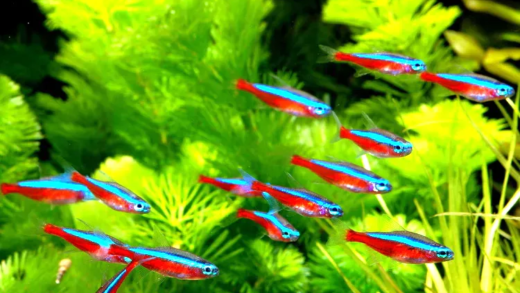Deep-sea dragonfish are vital to their ecosystems, utilizing bioluminescence for hunting, communication, and evasion. Various species demonstrate significant diversity, adapting uniquely to their environments. However, they face challenges like overfishing and climate change. Research methods such as ROVs and tagging enhance our understanding of these elusive creatures.
Understanding the Dragonfish: What is a deep-sea dragonfish?
Deep-sea dragonfish are remarkable creatures that dwell in the dark depths of the ocean. These unique fish belong to the family Opisthoproctidae and are known for their elongated bodies and large, fang-like teeth. Dragonfish can be found at depths ranging from 200 to 2,000 meters, where sunlight barely penetrates. This environment presents numerous challenges, making the adaptations of dragonfish particularly fascinating.
One of the most intriguing aspects of deep-sea dragonfish is their bioluminescence. This natural ability allows them to produce light, which plays a crucial role in their survival. The glowing organs, often located along their bodies, not only help them attract prey but also serve as a means of communication and camouflage in their dark habitat.
Deep-sea dragonfish exemplify a unique evolutionary path, showcasing the wonders of adaptation in extreme environments. By understanding these creatures, we gain insight into the complexities of life in the ocean’s depths.
The Magic of Light: How does the deep-sea dragonfish use bioluminescence?
Bioluminescence in dragonfish is a captivating phenomenon. These fish utilize light for various purposes, primarily for hunting and avoiding predators. The light produced by dragonfish can be emitted from specific organs, often resembling lures that attract unsuspecting prey. This strategy enhances their ability to capture food in the pitch-black waters.
Moreover, bioluminescence serves as a form of communication among dragonfish. During mating season, these creatures can signal each other using their light displays, contributing to their reproductive success. Additionally, the emitted light can confuse potential predators, providing dragonfish with an advantage in evading threats.
Overall, bioluminescence is not just a spectacle but a vital adaptation that helps dragonfish thrive in their challenging environment.
Survival Strategies: What adaptations help dragonfish survive in the dark ocean depths?
Dragonfish have evolved several adaptations that enable them to survive in the extreme conditions of deep-sea environments. Their large eyes are one significant feature, allowing them to detect the faintest light in the dark waters. This adaptation aids in spotting prey as well as potential threats.
Another crucial adaptation is their specialized teeth, which are sharp and pointed, perfect for gripping slippery prey. The long, slender bodies of dragonfish enable them to move efficiently through the water, while their bioluminescent capabilities enhance their hunting strategies.
Furthermore, dragonfish can adjust their metabolic rates according to the availability of food, allowing them to conserve energy during periods of scarcity. These survival strategies are essential for maintaining their position as top predators in their ecosystems.
Top of the Food Chain: The Predatory Status of Deep-Sea Dragonfish
The deep-sea dragonfish is a formidable predator in its dark ocean habitat. Known for its sharp teeth and bioluminescent capabilities, it holds a significant position in the marine food web. As a top predator, the dragonfish plays a crucial role in maintaining the balance of its ecosystem.
Several factors contribute to its predatory status:
- Efficient Hunting Techniques: Dragonfish use their bioluminescence to attract prey, making them effective hunters.
- Adaptations: With their large eyes and sharp teeth, they can detect and capture slippery prey in low-light conditions.
- Varied Diet: Dragonfish consume a wide range of organisms, including smaller fish and crustaceans, allowing them to thrive in diverse environments.
As top predators, deep-sea dragonfish help regulate populations of their prey, ensuring a healthy ecosystem. Their role emphasizes the importance of understanding these remarkable creatures.
Hunting Techniques: Prey of Deep-Sea Dragonfish
Deep-sea dragonfish exhibit unique hunting techniques that enhance their predatory efficiency. They primarily target smaller fish and crustaceans, capitalizing on their stealth and bioluminescence.
Their hunting methods include:
- Ambush Predation: Dragonfish often lie in wait, using their dark coloration for camouflage before striking.
- Bioluminescent Lures: They emit light to lure unsuspecting prey closer, making capture easier.
- Rapid Strikes: When prey is within reach, dragonfish use their sharp teeth to seize it quickly.
These hunting techniques not only showcase the adaptability of dragonfish but also highlight their role as apex predators in deep-sea ecosystems. Understanding their feeding habits is essential for appreciating their ecological significance.
Glow and Go: Attracting Prey with Bioluminescence
Dragonfish utilize their glowing lure to attract prey effectively. This bioluminescent adaptation is a key component of their hunting strategy, allowing them to thrive in the dark ocean depths.
Key aspects of this glowing lure include:
- Light Emission: Dragonfish can control the intensity and pattern of light emitted, making it more alluring to potential prey.
- Deceptive Appearance: The glow mimics the bioluminescent organisms that prey might normally seek, creating an irresistible target.
- Enhanced Capture Rates: By drawing prey closer with their lure, dragonfish increase their chances of successful hunts.
This unique hunting method demonstrates the incredible adaptations of deep-sea dragonfish, showcasing their mastery of survival in extreme environments. The interplay between bioluminescence and predation offers fascinating insights into the complexities of deep-sea life.
Role of Bioluminescence in Ecosystems
Deep-sea dragonfish play a vital role in their ecosystems through their bioluminescence. This fascinating capability not only aids in hunting but also contributes to the overall dynamics of deep-sea environments. Bioluminescence in dragonfish serves multiple functions:
- Prey Attraction: The light emitted by dragonfish lures various marine organisms, making it easier for these predators to catch their next meal.
- Communication: Dragonfish use bioluminescence to signal to each other, especially during mating, enhancing reproductive success.
- Predator Evasion: The glow can confuse potential predators, helping dragonfish to escape when threatened.
These functions underscore the importance of bioluminescence in maintaining a balance within the deep-sea ecosystem. By participating in the food web, dragonfish help regulate prey populations and contribute to the health of their environment.
Diversity of Dragonfish Species
There are several species of deep-sea dragonfish, each exhibiting unique traits that allow them to adapt to their specific environments. This diversity is essential for understanding the evolutionary paths these creatures have taken. Some notable species include:
- Idiacanthus fasciola: Known for its long body and distinctive bioluminescent patterns, this species thrives at great depths.
- Photostomias guernei: Featuring a robust jaw and a unique lure, this dragonfish uses its bioluminescence in innovative ways to hunt.
- Chauliodus sloani: Recognized for its sharp teeth and efficient predatory strategies, this species plays a critical role in its ecological niche.
Each species of dragonfish showcases adaptations that allow them to exploit different resources and survive in the competitive depths of the ocean. This variety highlights the ecological significance of dragonfish in marine biodiversity.
Challenges Faced by Dragonfish
Despite their remarkable adaptations, deep-sea dragonfish face numerous challenges in their environment. These threats can significantly impact their populations and ecosystems. Key challenges include:
- Overfishing: Increased fishing activities can deplete dragonfish populations, disrupting the food web.
- Climate Change: Alterations in ocean temperature and acidity can affect dragonfish habitats and prey availability.
- Pollution: Contaminants in the ocean can harm dragonfish health and reproductive success.
Addressing these challenges is crucial for the conservation of dragonfish and the health of deep-sea ecosystems. Protecting their habitats and regulating fishing practices are necessary steps to ensure the survival of these fascinating creatures.
Research Methods for Studying Dragonfish
Studying deep-sea dragonfish presents unique challenges due to their elusive nature and extreme habitats. Scientists employ various methods to learn more about these fascinating creatures:
- Remote Operated Vehicles (ROVs): Equipped with cameras and lights, ROVs allow researchers to observe dragonfish in their natural environment without disturbing them.
- Deep-sea Submersibles: These manned vehicles enable scientists to explore deeper waters and collect samples for analysis.
- Tagging and Tracking: Researchers tag dragonfish to monitor their movements and behaviors over time, providing insights into their ecology.
These research methods contribute significantly to our understanding of dragonfish and their role in deep-sea ecosystems, helping inform conservation efforts.





Comments are closed.